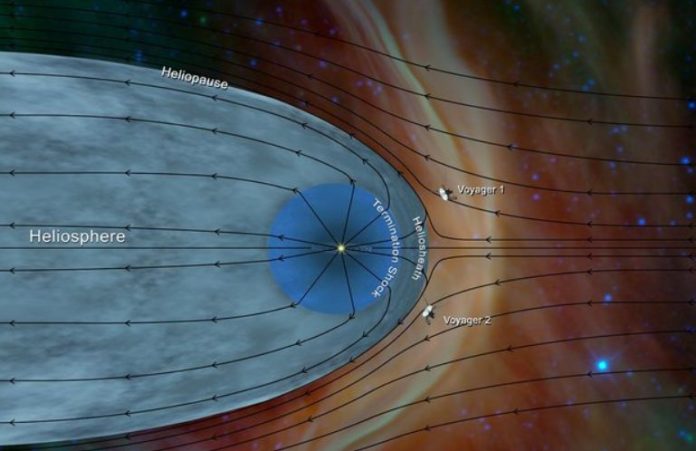Last November, Voyager 2 became the second man-made object in the history of mankind, which ended up in interstellar space. Now, several groups of astrophysicists working with probe data have published the results of their analysis, which confirmed this event and made it possible to learn about many properties of the boundary region of the heliosphere.
The Voyager program started in the late 1970s when two probes were launched to the giant planets of the solar system, which later went to its outskirts. Despite the fact that the initial term of the program was estimated at five years, the devices have been operating for 42 years. Now Voyager 2 is located at a distance of almost 122 astronomical units from the Earth. Voyager 1, the distance to which is 147.5 astronomical units, is considered the most man-made object from Earth.
On August 25, 2012, Voyager-1, located at a distance of 121.6 astronomical units from the Earth, crossed the heliopause, which is the boundary of the heliosphere (the area of space where the main The solar wind and magnetic fields of the Sun are part of the environment), and entered into the cold and relatively dense local interstellar medium (Very Local Interstellar Medium, VLISM). This was confirmed by a change in the recorded values of the magnetic field strength of the environment, and then by the properties of the plasma surrounding the apparatus. It is worth noting that the heliopause region is poorly understood and responds to any changes in the solar wind flow, so astronomers have to collect a large amount of data to confirm the moment of exit into the interstellar medium. So, for example, Voyager 1, before crossing the heliopause, visited two interstellar magnetic “tubes”, heliospheric mantle.
The announcement of Voyager 2’s interstellar release came as early as December last year, but only now are a few groups of astronomers working with data from more current scientific instruments, such as the CRS (Cosmic Ray Subsystem) and the LECP (Low-Energy Charged Particles) detection system, have published a number of articles on evidence of this event.
It turned out that the number of solar particles recorded by the instruments began to decrease gradually, starting on August 7, 2018, when Voyager 2 was at a distance of 118.2 astronomical units from the Sun, and the number of particles of galactic cosmic rays increased by 20% over the next few weeks. The sharp jump in particle concentration occurred on November 5, when the spacecraft was 119 astronomical units from the Sun, there was a decrease in the number of particles with an energy of more than 28-kilo electronvolts and an increase in the number of galactic cosmic rays with energy of more than 213 megaelectronvolts. The width of the boundary region of the heliosphere is approximately 1.5 astronomical units, the plasma in it slows down, heats up and is twice as dense as the plasma of the heliospheric mantle, and the boundary of the heliosphere is similar to the spherical front and has symmetry.
Data from the device show that the temperature of the local interstellar plasma is 30-50 thousand kelvin, while models predicted the temperature of 15 to 30 thousand kelvin, values interstellar magnetic field tensions were also higher than expected. Voyager 2 did not detect the presence of interstellar magnetic “tubes”, but found a boundary layer just behind the heliopause, a kind of magnetic barrier in which low-energy particles moved along the magnetic field. Thus, when you consider that both devices have left the heliosphere in different parts of it, the data obtained from them allow us to understand that the heliosphere and the local interstellar environment form complex interconnected, ever-changing system. It is worth noting that voyagers have not yet left the solar system, the boundary of which is outside the outer edge of the Oort Cloud, at a distance of about a hundred thousand astronomical units from the Sun.
